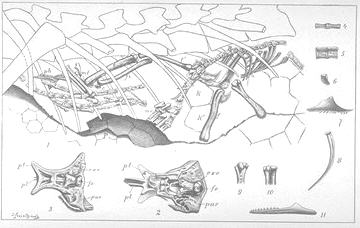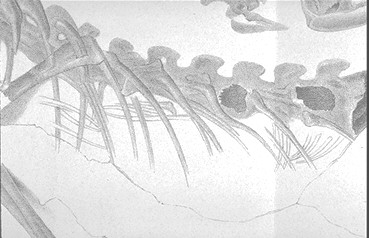13a. Nopcsa and a Dinner for Compsognathus, 1903
 In
1881 Othniel Marsh had a chance to examine the type specimen of
Compsognathus, described by Wagner in 1861, and he noticed that
within its ribs were the tiny bones of a small reptile. He thought it
might have been a foetus, but it could also have been a young of the same
species that had been swallowed. In other words, Compsognathus
could have been cannibalistic.
In
1881 Othniel Marsh had a chance to examine the type specimen of
Compsognathus, described by Wagner in 1861, and he noticed that
within its ribs were the tiny bones of a small reptile. He thought it
might have been a foetus, but it could also have been a young of the same
species that had been swallowed. In other words, Compsognathus
could have been cannibalistic.
Baron Nopcsa took a closer look. He rejected the possibility that the
small reptile was an embryo--it was too large for that--and on examining
the proportions of the bones, he concluded it was not a cannibalized
Compsognathus either. Rather, it appeared to be a small lizard that
was the very last course in this dinosaur banquet. 
In addition to the first evidence of dinosaur eating habits, Nopcsa
provided an illustration of the rib region of Compsognathus,
showing the lizard bones in question (see above right). This
illustration does not seem to have ever been reproduced, which is
unfortunate, since is remarkably successful in its difficult task. It is
interesting to compare Nopcsa's drawing with a detail of Wagner's original
plate of Compsognathus (detail at left; for Wagner's complete
plate, see
item 13).
 Source:
Source:Nopcsa, Baron F. "Neues ueber Compsognathus," in: Neues Jahrbuch fur Mineralogie, Geologie und Palaeontologie (Stuttgart), vol. 16 (1903), pp. 476-494. This work is in the Library Collections, but it is NOT on display.


 ®Linda Hall Library
®Linda Hall Library5109 Cherry Street
Kansas City, MO 64110
Please direct comments to ashwortb@lhl.lib.mo.us